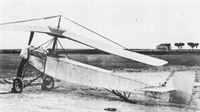Фотографии
-
Самолёты на фотографии: Cierva/Avro C.6 - Великобритания - 1924
-
Cierva’s first autogiro, the C.1, with heavily-braced, contra-rotating rotors, at Getafe aerodrome, Madrid, in 1920/21.
Самолёты на фотографии: Cierva C.1 / C.2 / C.3 - Испания - 1920
-
Another view of the C.1, which used a Deperdussin monoplane fuselage.
Самолёты на фотографии: Cierva C.1 / C.2 / C.3 - Испания - 1920
-
Cierva poses with the C.3, which was completed before the C.2, at Getafe in 1921.
Самолёты на фотографии: Cierva C.1 / C.2 / C.3 - Испания - 1920
-
The C.3 at Getafe in 1921 after an attempted take-off when powered with a 50 h.p. Gnome. An 80 h.p. le Rhone was later installed.
Самолёты на фотографии: Cierva C.1 / C.2 / C.3 - Испания - 1920
-
Seen intact, this autogiro featured warp control rods extending to the rotor blade trailing edges.
Самолёты на фотографии: Cierva C.1 / C.2 / C.3 - Испания - 1920
-
The C.2, with its five-bladed rotor, rolled to the right during tests with the result depicted.
Самолёты на фотографии: Cierva C.1 / C.2 / C.3 - Испания - 1920
-
Cierva holds a model of the C.2 made in Escuela Industrial, 1922.
Самолёты на фотографии: Cierva C.1 / C.2 / C.3 - Испания - 1920
-
The BCD.1 "Red Crab" was the first successful indigenous Spanish aircraft. It is seen here at Cuatro Vientos aerodrome.
Самолёты на фотографии: Cierva/Barcala-Cierva-Diaz BCD.1 Cangrejo - Испания - 1911
-
The le Rhone-engined BCD.2 monoplane at Getafe aerodrome, Madrid, 1913.
Самолёты на фотографии: Cierva/Barcala-Cierva-Diaz BCD.2 - Испания - 1913
-
The trimotor at Cuatro Vientos, Madrid, in May 1919, with its three 220 h.p. Hispano-Suizas in evidence.
Самолёты на фотографии: Cierva/Barcala-Cierva-Diaz BCD.3 - Испания - 1918
-
Juan de la Cierva in the rear gunner's cockpit of his trimotor bomber.
Самолёты на фотографии: Cierva/Barcala-Cierva-Diaz BCD.3 - Испания - 1918
-
The ill-fated bomber being manoeuvred into its hangar at Cuatro Vientos, May 1919.
Самолёты на фотографии: Cierva/Barcala-Cierva-Diaz BCD.3 - Испания - 1918
Статьи
- -
- Curtiss Sparrowhawk /Preservation Profile/ (72)
- News Spotlight
- Personal album
- Stag Lane /Gone but not forgotten/ (1)
- ??? - The Famous Grouse DH Moth Air Rally
- B.Boddy - Buckle's baby
- D.Middleton - Airspeed's Clay Pigeon
- F.Adkin - Memoirs of Aircraftsman (4)
- H.Hagen - Ansaldo Restoration
- L.Curtis - Anything To Anywhere (4)
- P.Capon - Cierva's first autogiros (1)
- R.Williams - Ensigns for the Empire (2)












